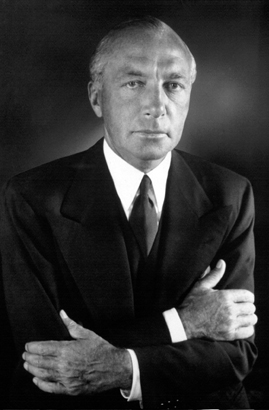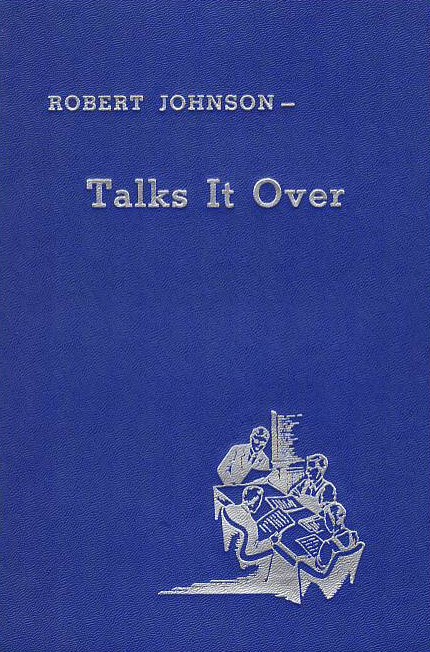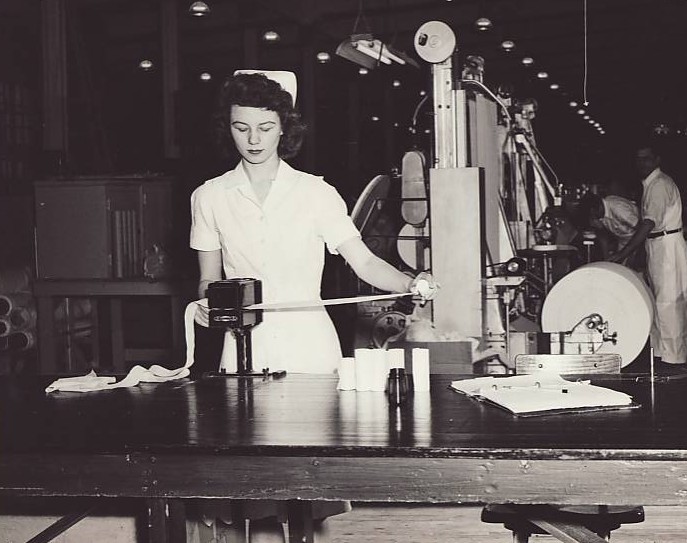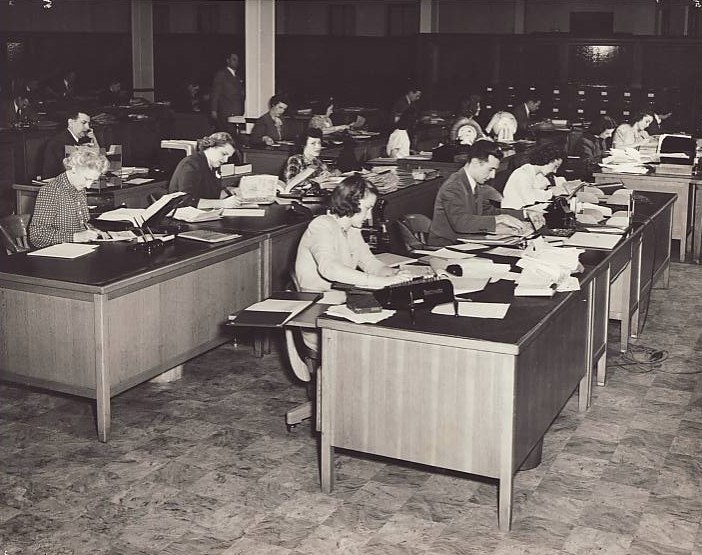Robert Wood Johnson -- Blogger?

General Robert Wood Johnson – a blogger? Of course, he wasn’t -- because Johnson (1893 – 1968) was from an era long before the internet and blogs. But…there’s some interesting evidence that if he were around today, he might perhaps be blogging. And what could that evidence possibly be? It was that he wanted his communications with Johnson & Johnson employees around the world to be two-way conversations and he tried to figure out a way to do that, but felt limited by the constraints of the technology that was available in the 1940s.

Cover of Robert Johnson Talks it Over
In 1949, Johnson published a book called Robert Johnson Talks it Over, which was a compilation of radio talks he had recorded for employees worldwide. These talks were played over the broadcasting systems in the Company’s plants and offices. Each talk explained in great detail a different aspect of Johnson & Johnson, since Johnson felt that every single employee, no matter what he or she did, should thoroughly understand every part of the business in order to fully contribute to it. According to Johnson, the recorded talks were meant to replace the informal conversations he used to have when the Company was much smaller and he knew everyone who worked there. He wrote:
“Years have passed since I knew everyone in our organization. There once was a time, however, when I did know – at least, I recognized – every man and woman who worked with Johnson & Johnson. Those men and women knew me, too, and we’d get together once in a while to talk about the Company, its progress, and its problems. In those talks I learned how others felt, and they learned what was on my mind. Anyone might ask questions, and could get answers telling just what he wanted to know.”
“We have grown too large for such discussions; if we tried to hold them now, we’d have meetings with speakers and a lot of formality, but few real results.” [Robert Johnson Talks it Over, page 1]
Here’s the interesting part. (Besides the fact that he wasn’t a fan of big, formal meetings.) Robert Wood Johnson mentioned all of the things the Company was doing to communicate to employees – internal newspapers and magazines, special booklets, the Suggestion System, and more. But he wrote that they were too formal and one-way, and he was looking for something that would come close to those two-way person-to-person talks he used to have…which is why he came up with the idea for the broadcasts. Johnson lamented the fact that the technology of the time limited these talks to one-way broadcasts, when he would have preferred them to be conversations.
“The broadcasts, of course, will have one disadvantage: I shall do most of the talking, while you will have no chance to throw in comments, questions or requests for explanations.” [Robert Johnson Talks it Over, p. 2]
So Johnson did what he could to make these broadcasts more like conversations. Their tone was informal. And in the first chapter of Robert Johnson Talks it Over, he listed ways in which these one-way talks could be made more two-way, or at least answer some of the questions from employees that would come up. Since the talks were being published, Johnson included additional information that would answer some of the questions employees might have; and he encouraged employees to talk to their supervisors and local management, who could either answer the question themselves or see that it went to the proper places to be answered. It wasn’t a perfect system, but it was the best he could do at the time.


Some employees in the 1940s -- the audience for Johnson's broadcasts
Johnson was a prolific author of books and articles and he loved to exchange ideas. He was often quoted in the press about his business philosophy and current business-related events. In keeping with his well-earned reputation as a maverick, he was a good source of quotable quotes, and he didn’t shy away from having public conversations about the issues of the day…such as the need for fair wages and hours during the Great Depression, or the social responsibilities of business. So…Robert Wood Johnson believed in two-way, conversational communication with employees, he wasn’t shy about expressing his opinions, and he wrote a lot of books and magazine articles. Sounds like he could have been a potential blogger well ahead of his time!

I think that some of the top management of today´s company still thinking the same way (60 years of difference). I work in Chile an I have e-mail EVEN our CEO and he reply , short message , but he reply. I have share my ideas with top management , received feedback and share strategies with employees of other countries such as China, France, UK and US and for the record I only work as a Junior Sales Rep
Well, I encourage everyone to do it .......
Hi, Kilmerhouse and J & J archives 9/27/2008
Can you help this London historian of medicine with his query, please? And copy me--I'm curious, too.
Thanks--and with continuing thanks for all the help Elisabeth King and J & J gave me on my own book, A State of Health: New Jersey's Medical Heritage, Rutgers Univ Press, 2001)
Karen Reeds, Ph.D.
President, Medical History Society of NJ
[email protected]
Date: Fri, 26 Sep 2008 09:44:41 -0400
From: "Nathan Ensmenger, H-SCI-MED-TECH"
Subject: Re: Query: History of bandaids or elastoplasters?
From: Mike Michael
Dear all,
By way of clarification of my previous request, I'm looking for texts
which have addressed how everyday medical technologies such as bandaids
or elastoplasters have become standardised (to particular sizes,
materials, antiseptics, adhesives and so on).
Essentially, I'm interested in exploring the prehistory of this, as it
were: broader histories of wounds and dressing. Then I'd follow up with
a consideration of the processes by which these came to be standardised
as artefacts for 'domestic' use. As such, I'd be aiming to examine what
sorts of assumptions about bodies, disease, social relations and
medical/professional expertise inform such standardisation. Finally, I'm
interested in thinking about, on the one hand, the implications of
de-standardization (if that's the right term) as the range of plasters
proliferates, and, on the other, the ambiguities of social
standardization (that is, how commercial plasters complicate/reinforce
certain assumptions and expectations about cultural, political and moral
relations).
So, once again, any pointers to relevant texts would be hugely
appreciated. many thanks Mike
Mike Michael
Professor of Sociology of Science and Technology
Director, Centre for the Study of Invention and Social Process
Department of Sociology
Goldsmiths College
University of London
New Cross
London SE14 6NW
Tel.: +44 (0)207 919 7706
Fax: +44 (0)207 919 7713
> Mike Michael Sociology Department, Goldsmiths, University of London
> wrote:
>
>
>> Hi,
>> I'm interested in histories of the development and standardisation of
>> bandaids or elastoplasts. Can anyone advise on resources/references? I'm
>> alos keen to familiarise myself with broader histories of wounds and
>> dressing. Again, any pointers? Thanks.
>>
>> Mike Michael
>>
Dr. Reeds and Dr. Michael,
I'm not sure we have the information you're looking for about how adhesive bandages came to be in standard sizes, but we will do some checking. To start, I can point you to two posts about the invention of BAND-AID® Brand Adhesive Bandages, which are here: http://www.kilmerhouse.com/?p=25 and here: http://www.kilmerhouse.com/?p=454
Hangin’ With Johnson and Johnson...
I’m back!
It was a whirlwind trip to beautiful Orlando, Florida to speak at Johnson and Johnson’s Global Communications Conference.
I had an absolute blast!
I’m standing here with my co-panelist Lisa Emrich, author of Brass and Ivory, her blog ab...